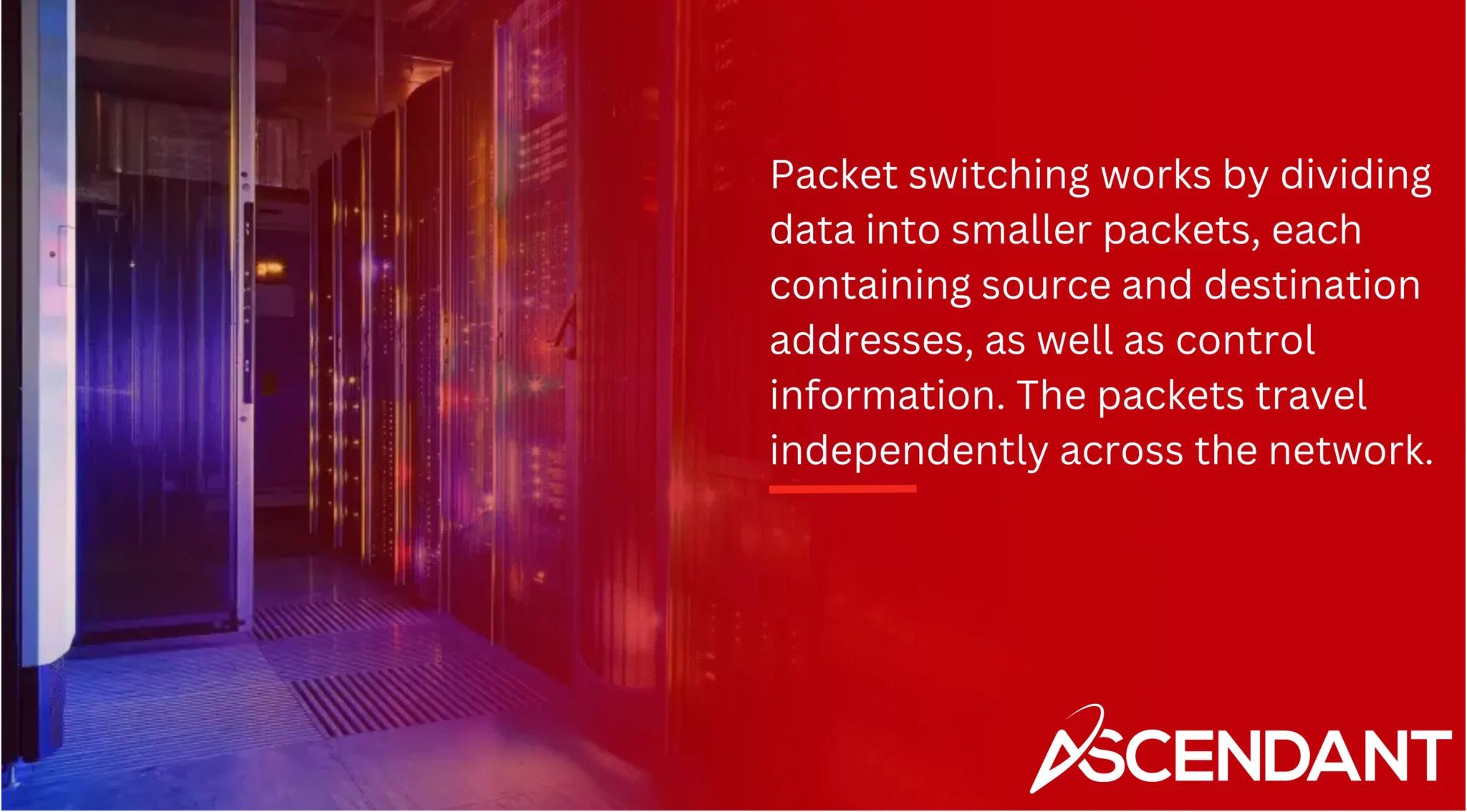Packet switching is essential for fast and reliable data transmission in digital networks. It divides data into packets that travel independently, optimizing network efficiency and handling large volumes of traffic. This technology powers the internet and ensures seamless communication between devices. In this article, we’ll explore how packet switching works, compare it to other methods, and examine its benefits and drawbacks.
Key Takeaways
- Packet switching allows for efficient use of network resources by dynamically routing data packets, enhancing the speed and reliability of data transmission.
- Two primary types of packet switching—datagram and virtual circuit—offer distinct advantages, with datagram focusing on flexibility and virtual circuit ensuring ordered delivery.
- Despite its benefits, packet switching faces challenges such as packet loss and latency, which can impact network performance; ongoing advancements aim to address these issues.
Understanding Packet Switching
In communication networks, packet switching is employed to efficiently transmit data by packaging it into discrete packets. Each packet encompasses a segment of the total information along with control details—the payload and the packet header—crucial for ensuring swift and dependable delivery across digital networks. As a foundational element in contemporary network designs, this method significantly improves resource sharing amongst numerous users while managing vast volumes of concurrent data.
This technique stands in contrast to circuit switching where a fixed path must be established throughout an entire communication session. Packet switching offers greater flexibility as each individual packet may traverse different routes within the network based on availability, thereby maximizing effective utilization of network capacities. Due to its dynamic allocation capabilities that bolster both efficiency and performance during transmission processes, packet switching has become indispensable within our globally connected society.
How Packet Switching Works

Packet switching works by dividing data into smaller packets, each containing source and destination addresses, as well as control information. The packets travel independently across the network. They take various paths depending on the current conditions. Dynamic routing enables packets to bypass busy or downed paths, ensuring efficient data transmission despite network congestion.
Routers are vital in this process, evaluating each packet’s destination address to determine the optimal route. IP addresses are assigned to each packet for unique identification, and sequence numbers help reorder out-of-order packets at the destination.
This way, packet switching ensures that data reaches its destination accurately and promptly, even if the packets do not arrive in the order they were sent.
Key Differences: Circuit Switching vs. Packet Switching
Packet switching and circuit switching are two distinct methods of data transmission. Packet switching is advantageous as it allows the movement of data packets across multiple routes within a network, promoting efficient usage of available network resources by adapting to traffic fluctuations – similar to how letters may be routed through various paths in a postal system before reaching their intended destination. In this approach, each packet finds its way efficiently around the network, making it particularly suitable for today’s ever-changing and bandwidth-intensive communication demands prevalent in a packet-switched network.
In contrast, circuit switching operates on an entirely different principle once established. There’s a dedicated path that remains constant throughout the entire duration of the communication session — similar to having an exclusive phone line. This process provides fixed bandwidth and steady connection quality, but at the expense of flexibility and overall efficiency when juxtaposed with packet switching.
Exploration into these categories unveils two principal types – datagram packet switching and virtual circuit packet switching – both offering distinctive advantages which will be Dissected in subsequent sections.
Types of Packet Switching
In the following sections, we will explore two main packet switching methods: datagram packet switching and virtual circuit packet switching. Both have unique characteristics and applications that distinguish them from each other.
Datagram Packet Switching
Packet switching in communication networks allows each packet to carry its own address, making it possible for them to be routed independently through the network. This autonomy permits packets to follow diverse paths toward their intended destination, thereby increasing the robustness and adaptability of the network. Nevertheless, this method can lead to packets arriving at their destination out of sequence, necessitating extra routing protocols that arrange them correctly upon arrival.
There are various datagram packet switches like store-and-forward switches, fragment-free switches or cut-through switches which dictate how a network manages packet transmission during their journey across it. The application of this system is particularly advantageous in situations where adaptable routing and redundancy are essential. An exemplary case is the large-scale internet networks fundamental for modern digital communication.
Virtual Circuit Packet Switching
In contrast, virtual circuit packet switching sets up a logical path prior to the transmission of data, which ensures that all packets adhere to an established route. This approach secures ordered delivery since every packet traverses the identical path, simplifying the process of managing and reassembling the data upon arrival at its destination.
By creating a predetermined route for packets to follow, virtual circuit packet switching delivers enhanced dependability and uniformity—characteristics that are especially beneficial for applications demanding maintenance of data integrity and sequence. This technique merges the benefits associated with both circuit switching and packet switching, providing a versatile solution suitable for varied communication needs.
Advantages of Packet Switching
In modern communication networks, packet switching is often favored over conventional circuit switching due to its numerous benefits. This includes the efficient utilization of network resources as well as enhanced flexibility and scalability, which are aspects we will delve into comprehensively in subsequent subsections.
Efficient Use of Network Resources
Utilizing statistical multiplexing, packet switching dynamically allocates transmission resources to enhance the efficiency of the network. This process allows for numerous data transmissions to concurrently utilize network resources, thereby preventing congestion and identifying quicker routes for delivering packets. Within local area networks (LANs), this efficient technique enables the distribution of packets across several devices without requiring exclusive connections.
The performance of a network is enhanced by resending only those packets that were lost rather than conducting comprehensive retransmissions, thus boosting throughput significantly. By dynamically assigning resources according to fluctuating traffic patterns, this method ensures optimal use of available bandwidth and augments the overall experience for users.
Flexibility and Scalability
Packet-switched networks possess an impressive capacity for adaptability and can expand effortlessly to accommodate growing demands for data. These networks are distinct from circuit-switched networks that depend on dedicated connections, as they have the capability to handle surges in traffic with minor alterations to their infrastructure. The independent transmission of packets contributes significantly to this flexibility by facilitating dynamic routing across the network.
In packet-switched networks, bandwidth allocation is dynamically managed, which enhances the network’s ability to respond effectively to fluctuating traffic conditions and ensures optimal resource utilization. As data volume escalates, these systems demonstrate a smooth transition in performance levels while preserving consistent reliability without relying on established circuits or pathways.
Challenges and Disadvantages of Packet Switching
Packet-switched networks, while beneficial in many ways, encounter certain difficulties, especially when network traffic is heavy. Problems like latency and the loss of packets can impact how well these networks function, which we will delve into more deeply in subsequent subsections.
Packet Loss and Error Handling
Several circumstances can cause packet loss within a network, such as congestion on the network, failures of hardware components, and errors during transmission. This kind of loss often leads to issues like delayed data delivery, the need for retransmission of packets which contributes to increased latency time and also impacts negatively on total throughput during communication over networks.
On the other hand, protocols such as the Transmission Control Protocol (TCP) provide reliable means for packet transportation by fostering connection-oriented communications that ensure all packets are successfully delivered to their intended destination. TCP is responsible for managing error detection and correction along with handling any necessary retransmissions in order to transmit data effectively while maintaining its integrity throughout the process.
Latency and Delay
In packet-switched networks, the issues of latency and delay are paramount since they have a direct impact on functionality and how users experience the network. Elevated levels of latency can lead to sluggish data transmission that may impede applications that rely on real-time interactions, such as video calls or online gaming.
Advancements in networking technology aim at boosting throughput while slashing the latency associated with packet movement. For example, edge computing enhances performance by conducting data processing near its origin point. This not only mitigates latency and eases network congestion, but also improves efficiency within these computer networks by shortening the journey required for data packets to traverse.
The Role of Routers and Network Protocols
In packet-switched networks, routers and protocols play critical roles in facilitating efficient communication. Routers are responsible for guiding packets of data toward their specified IP addresses, while network protocols govern the process of communication to boost the effectiveness of data transmission across the network.
Routing Packets
In packet-switched networks, routers play a crucial role by connecting various networks and managing the flow of data packets according to their intended destination IP addresses. These devices employ specific algorithms that scrutinize the headers of each packet and dynamically adjust their routing tables, which promotes effective transit for all packets across the network. The Store and Forward method used by routers involves holding each packet momentarily at every node along its path before sending it forward, thereby improving the reliability with which packets are delivered.
By examining both source and destination addresses contained within each packet, routers are equipped to individually direct them through varying routes tailored to current network conditions. This adaptability allows for seamless navigation around points of congestion or broken links in the network while ensuring efficient transmission of data from one point to another without loss or significant delay.
Common Protocols
Packet switching, which is overseen by the Internet Protocol (IP), is a fundamental network protocol responsible for directing packet routing within various networks.
There are several well-known protocols that utilize virtual circuit switching.
- X.25
- Frame Relay
- ATM (Asynchronous Transfer Mode)
- MPLS (Multiprotocol Label Switching)
For local area networks (LANs), Ethernet technology employs packet-switched methods to facilitate communication amongst multiple devices on the same network.
In environments where reliable transmission over packet switched networks is crucial, Transmission Control Protocol (TCP) offers essential services such as error checking and data restoration. Alternatively, User Datagram Protocol (UDP) caters to scenarios requiring swifter but less reliable transfer of information—ideal for applications like video streaming where speed trumps assurance of delivery.
Real-World Applications of Packet Switching
In various practical settings, packet switching enhances the resilience and efficiency of data transmission. This technique is essential in ensuring reliable and efficient communication across local area networks (LANs) as well as facilitating internet connectivity by adeptly managing data handling within these networks.
Internet Communication
The essence of internet architecture lies in packet switching, which plays a pivotal role in routing and making an efficient use of network resources. Packet switching’s dynamic rerouting capability enhances the dependability of data transmission over the internet by enabling packets to bypass bottlenecks or damaged links. This adaptability is essential for preserving strong and reliable connectivity across the web, particularly when networks are strained during periods of high demand.
Meanwhile, communication protocols such as UDP offer quick, connectionless transfer services that are perfect for tasks like video streaming. Despite not assuring packet delivery, UDP remains preferable for real-time activities because its rapidity compensates for tolerable instances of packet loss. The integration of speed with efficiency illuminates why packet switching is critical to ensuring uninterrupted functioning throughout the vast expanse of the internet.
Local Area Networks (LAN)
In Local Area Networks (LANs), packet switching plays an indispensable role in the management and efficient transmission of data across various devices. Each Ethernet packet is comprised of two main parts: a header that includes critical information such as source and destination MAC addresses, type of protocol, along with error detection codes. And a payload which contains the actual data to be conveyed. The structure provided by this format facilitates targeted and streamlined communication within the network.
The importance of payload lies in its function as the carrier for the transmitted data – it is fundamental to achieving effective communication within LANs. Packet switching empowers these networks to dynamically handle transmissions, optimizing utilization of network resources while also ensuring dependable interactions among connected devices.
Future Trends in Packet Switching
Emerging technologies and innovative approaches are set to substantially advance packet switching, with the integration of artificial intelligence (AI) and Software-Defined Networking (SDN) at the forefront. These integrations aim to refine network performance and heighten operational efficiency.
As a result, we can expect these evolutions to revolutionize the operation of packet-switched networks by rendering them more efficient and flexible in their adaptability.
Advancements in Network Hardware
Enhanced processing capabilities are a hallmark of next-generation routers, allowing them to handle the rising volumes of data traffic with greater efficiency. These cutting-edge routers utilize sophisticated algorithms that dynamically optimize routing decisions in accordance with live network circumstances, leading to swift and dependable delivery of each data packet. In parallel, contemporary switches have evolved to accommodate higher rates of data throughput while managing several streams concurrently, which contributes markedly to improved network functionality.
These advancements across both routers and switches substantially boost the performance metrics concerning the transfer and reliability of network packets. Such hardware upgrades play an integral role in meeting the escalated demand for data within current communication networks by ensuring that packet-switched networks maintain their operational efficacy and excellence.
Enhanced Security Measures
Contemporary encryption techniques are applied to guarantee the safety and privacy of data within packet-switched networks. These advancements in encryption protocols work to secure packets of data as they traverse through the network, thereby preventing access by unauthorized individuals. This is crucial for preserving confidence and dependability within communication networks.
Securing communication via encrypted data packets bolsters the security infrastructure within these networks. As packet-switched networks expand their capabilities handling large amounts of sensitive information, prioritizing security becomes imperative for ensuring protected transmission across these complex communications frameworks.
 Summary
Summary
Communication networks have experienced a significant transformation with the advent of packet-switched networks, which provide distinct benefits when compared to traditional circuit switching. This method promotes more efficient utilization of network resources and offers flexibility and expandability to cope with today’s high-demand communication scenarios. Even though issues such as latency and packet loss can arise, ongoing improvements in networking equipment along with advanced encryption protocols consistently improve its efficacy and dependability.
Looking ahead, the adoption of artificial intelligence (AI) alongside software-defined networking (SDN) is expected to refine these already efficient packet-based networks by enhancing their adaptiveness and efficiency. With continuous technological developments in this area, it’s clear that packet switching will remain an essential foundation for digital communications systems, ready to meet the expanding data demands within our highly connected society.
Frequently Asked Questions
What is packet switching?
Packet switching is a method that breaks data into packets for efficient and reliable transmission over digital networks. This approach optimizes communication by allowing multiple packets to travel independently to their destination.
How does packet switching differ from circuit switching?
Packet switching differs from circuit switching in that it doesn’t require a dedicated path for communication; instead, it allows data packets to take various routes, thereby optimizing network resources and increasing flexibility.
What are the main types of packet switching?
The main types of packet switching are datagram packet switching, where each packet is routed independently, and virtual circuit packet switching, which establishes a predefined path for packets.
Understanding these two methods can enhance your knowledge of network communication.
What are the primary advantages of packet switching?
The primary advantages of packet switching are its efficient use of network resources and flexibility, which enable it to adapt to dynamic and high-demand communication environments.
This scalability makes it an ideal choice for modern networking needs.
How is packet loss managed in packet-switched networks?
In packet-switched networks, protocols such as TCP are instrumental in assuring the reliable delivery of data by adopting error checking and retransmissions to preserve the integrity of data.
This strategy confirms that any packets lost during transmission are reissued, thus improving the dependability of network communication.

